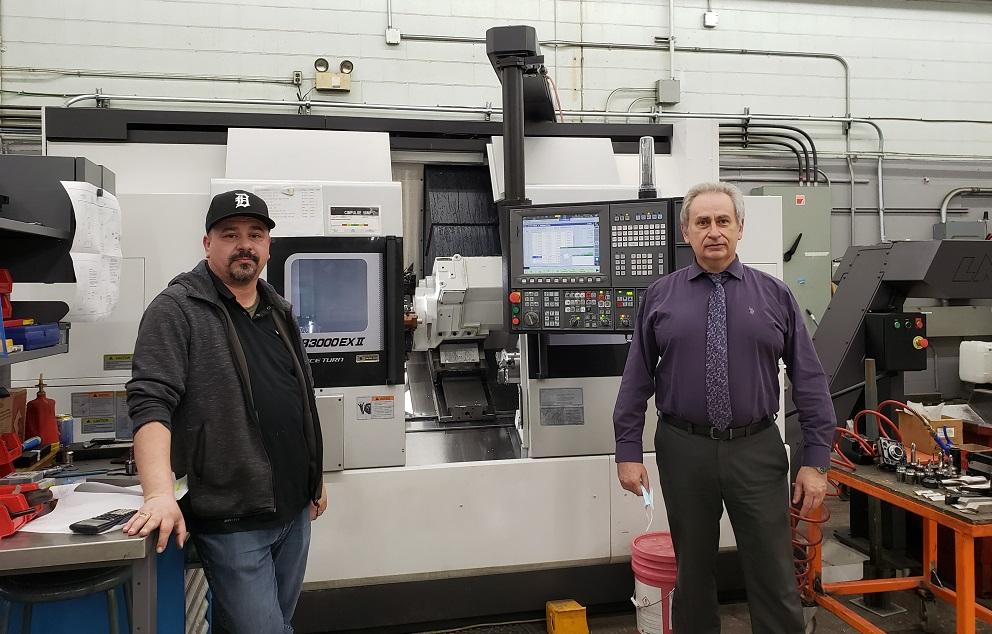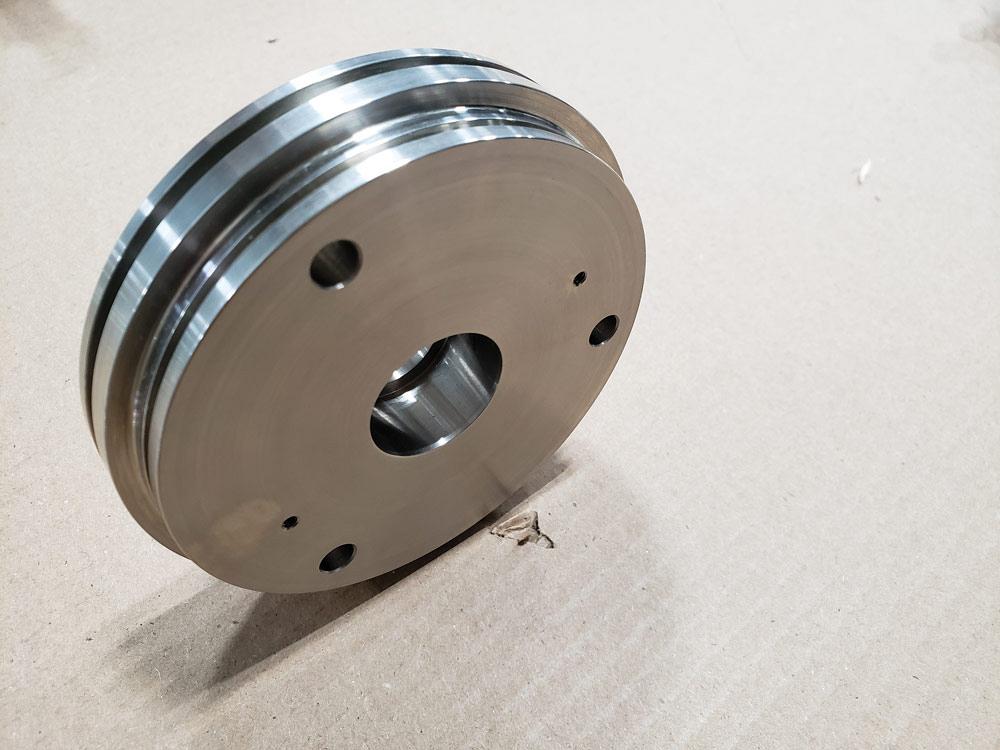Associate Editor
- FMA
- The Fabricator
- FABTECH
- Canadian Metalworking
Toronto machine shop maximizes multitasking
Kelk uses horizontal lathe to expand the range of parts it can produce in-house
- By Lindsay Luminoso
- June 7, 2021
- Article
- Metalworking

Jimmy Glamcevski (left) and Stefan Georgiev have spent the last few years focused on upgrading the shop’s machines, including the addition of a new Okuma LB3000 EX II-MYW horizontal lathe with multitasking capabilities. Images: Kelk Corp.
Kelk has become globally recognized as a leader in electronic measuring equipment for steel and aluminum rolling mills, paper mills, and mining applications. The company was founded in 1953 by George Kelk, an engineer by education who previously was involved in the aerospace industry. Instead of remaining in this field, he decided to use the knowledge he acquired in strain gauge technology to develop sensors for the steel mill rolling industry.
Kelk has grown over the years, developing many sensors, but has remained focused on custom and high-precision production of load cells and other specialized opto-electromechanical equipment and components. In 2013 Kelk Corp. was acquired by Vishay Precision Group (VPG) and became Vishay Precision Group Canada.
“What differentiates the Kelk brand from our competitors is that our products are very robust,” said Stefan Georgiev, production manager at VPG Canada (Kelk) in Toronto. “A steel mill runs 24/7, and if the equipment fails, an hour of downtime can be catastrophic, costing anywhere between $60,000 and $100,000 in losses. If a mill decides to go with low-quality components, they cannot expect reliability. We offer high-quality and reliable parts for these mills. It is really a niche market we are working in, and this is why almost all our products are custom-built. Our best year was 2019 when we produced the highest number of load cells and optical systems for the steel mill rolling sector. We are really focused and specialized in this industry.”
Although the company’s sensors are used in steel mills all over the world – it exports 98 per cent of all production – the company’s headquarters are in Toronto. This location houses its head office, engineering, research, sales and services, as well as manufacturing.
Machine Shop
The company’s machine shop with its seven CNC machines and five manual machines is relatively small compared to other operations. Over the past few years, the company has invested in new equipment to ensure that it is up to standards and can produce high-quality parts. The machine shop mainly produces load cells and parts for optics and electronics used in sensors and systems for steel mills.
“We’ve really been focused on updating the machine shop,” said Jimmy Glamcevski, machine shop manager. “We have always needed manual machines for repair of returned products or for fine-tuning parts, but they lead to painstaking and time-consuming labour. Since most of our products can be machined on a CNC, we have upgraded most of our machines to the latest and high-quality ones. We recently purchased an Okuma horizontal lathe, as well as a double-pallet vertical machining centre and a horizontal machining centre, and we are currently looking at adding another vertical machine. It’s been a slow but necessary process.”
When considering new machines, Kelk has focused on operations and specifications. It is not just about one brand or one type of machine; the shop needs to have many options to ensure that complex and custom components can be produced efficiently. The industry is very specialized, and according to Glamcevski, there are very few companies that produce the parts that Kelk does. The company produces only one or two finished parts per week, but those parts have tight tolerances and specifications.
When it comes to producing the load cell, the part comes into the shop as a very large forging, which is part of one of two families, either circle or rectangle. These forgings then need to be roughed, removing the scale. The shop primarily works with stainless steel, 17-4 PH, 420, and sometimes AISI 4340. Once the parts have been roughed, they are moved to a vertical or horizontal machining centre, depending on the features and specifications.
From there the parts move to a horizontal mill for deep-hole drilling, which Kelk specializes in. Many companies still use gun drilling, as did Kelk until about five years ago. After the shop invested in a machine that was precise enough to do deep-hole drilling, instead of spending 20-plus hours performing gun drilling operations, it could output one or two parts on the machine per day. At the end it uses a burnishing tool to enhance the surface quality.
“In these deep holes we are installing our strain gauges, so surface quality is very important,” said Georgiev. “Some of the slots have 60 or more strain gauges installed, and if one gauge fails, then everything fails. So, the most important feature of our machine shop is productivity, precision, and reliability. We produce load cells that can range from 300 kg up to 7,000 tonnes’ capacity, which is exceptionally high. However, when we are producing small load cells or small components, we need a machine that makes sense for those parts.”

The Okuma machine is perfect for small parts, especially ones with low weights. Most of the shop’s other machines produce 18- to 42-in.-dia. parts, while the Okuma machine is used to produce its 10-in.-dia. family of tensiometers.
Multitasking Machine
In 2019 the shop was searching for a new machine, specifically one that was precise and could increase productivity. Both Georgiev and Glamcevski were looking for a CNC machine to produce one of the company’s family of products, while they were still outsourcing other parts, with the hope that the machine could be used to bring some of these families in-house.
They also wanted a machine that could limit setup time. The shop currently runs only one shift per day, approximately 39 hours per week. Setup time can make all the difference in how many parts the shop can produce. A two-hour setup time can be costly, especially if the shop is working on 10 different products during the week. With over 25 different part designs needing to be produced each month, this downtime adds up.
“We really wanted something that would eliminate having a part sitting around waiting for setup on a machine and the machines sitting idle in the process,” said Glamcevski. “If we could reduce setup time or have to set the part up only once on one machine, it becomes more valuable to us.”
The shop was previously working with an older lathe that was still operating well but was limited on what parts could be produced on it. In summer 2019 the shop purchased an Okuma LB3000 EX II-MYW horizontal lathe from EMEC Machine Tools, Mississauga, Ont.
“We really wanted something that could do multitasking operations and cover a large range of families of our products,” said Glamcevski. “That’s why we chose the Okuma machine. It includes a double spindle so we do not have to use a bar feeder. That eliminates the need for the additional floor space and time of working and maintaining a bar feeder. There are so many different and new features of the machine that we are still learning how to best take advantage of them even today.”
Once the machine was installed, all operators were given as much training as possible. If there is a new feature or capability that the shop wants to use, Glamcevski said that they can easily call on EMEC or Okuma to come in to explain and train.
The shop is currently exploring whether it makes sense to bring in-house some of the part families that are subbed out. To do this, it needs to consider material type, tooling needs and specifications, how to prove out the process, prototyping, program development, and testing of the finished part for quality. If all these can be checked off, then the part can be made in-house. It is a process that they hope will make the shop more efficient while still maintaining the high standard of quality.
“The Okuma machine is perfect for small parts, especially ones that weigh less,” said Georgiev. “Most other machines are producing 18- to 42-in.-dia. parts, but on the Okuma we decided to machine our 10-in.-dia. part family of tensiometers. It is important for us to have this machine available when we need it. In our business, it is not a matter of having a part done in the next 15 minutes; we prioritize quality. One of the harshest environments for parts made of stainless steel and the like is in a steel mill. With nearly 48 per cent of the steel mills in the world using Kelk products, our customers expect longevity and quality from our products. With this machine, we are able to ensure that quality component for the small parts.”
The family of tensiometers produced on the horizontal lathe have unique profiles, especially the ones for steel and aluminum mills and process lines. These parts must be very precise and need to provide high accuracy to the controller of the mill. The Okuma machine allows for the shop to easily produce one of the 40 different profiles, with varying characteristics and outputs, with live tooling and greater programming flexibility. Another family product group that will be produced on the machine is the Accuspeed laser velocimeter. Some of these components need to be machined with very tight tolerances, which can be quite difficult if the part requires many different setups.
“The one thing that we've seen gains on with this machine is improved accuracy,” said Glamcevski. “We had an older lathe that was a little worn. The Okuma machine is new and accurate. The learning curve can be a bit of a challenge, especially with live tooling and double spindles, but you are really going to get that with any new machine. Right now I do not think we are using the machine to its full advantage, to be honest, but in time we will be closer to where we want to be in terms of maximizing the machine. There is a reason we manufacture the way we do. We have a process in place that aligns with the founder’s vision of the company, which places quality above all else. The machines we invest in and the way we do things ensure that when we put the Kelk name on our products, we can stand behind them.”

The family of tensiometers produced on the Okuma machine have unique profiles, especially the ones for steel and aluminum mills and process lines. The shop is currently moving production of its Accu-speed laser velocimeters, including this cover, to the Okuma machine.
Associate Editor Lindsay Luminoso can be reached at lluminoso@canadianmetalworking.com.
Vishay Precision Group Canada (KELK), kelk.com
About the Author

Lindsay Luminoso
1154 Warden Avenue
Toronto, M1R 0A1 Canada
Lindsay Luminoso, associate editor, contributes to both Canadian Metalworking and Canadian Fabricating & Welding. She worked as an associate editor/web editor, at Canadian Metalworking from 2014-2016 and was most recently an associate editor at Design Engineering.
Luminoso has a bachelor of arts from Carleton University, a bachelor of education from Ottawa University, and a graduate certificate in book, magazine, and digital publishing from Centennial College.
Related Companies
subscribe now


Keep up to date with the latest news, events, and technology for all things metal from our pair of monthly magazines written specifically for Canadian manufacturers!
Start Your Free Subscription- Industry Events
MME Winnipeg
- April 30, 2024
- Winnipeg, ON Canada
CTMA Economic Uncertainty: Helping You Navigate Windsor Seminar
- April 30, 2024
- Windsor, ON Canada
CTMA Economic Uncertainty: Helping You Navigate Kitchener Seminar
- May 2, 2024
- Kitchener, ON Canada
Automate 2024
- May 6 - 9, 2024
- Chicago, IL
ANCA Open House
- May 7 - 8, 2024
- Wixom, MI




















